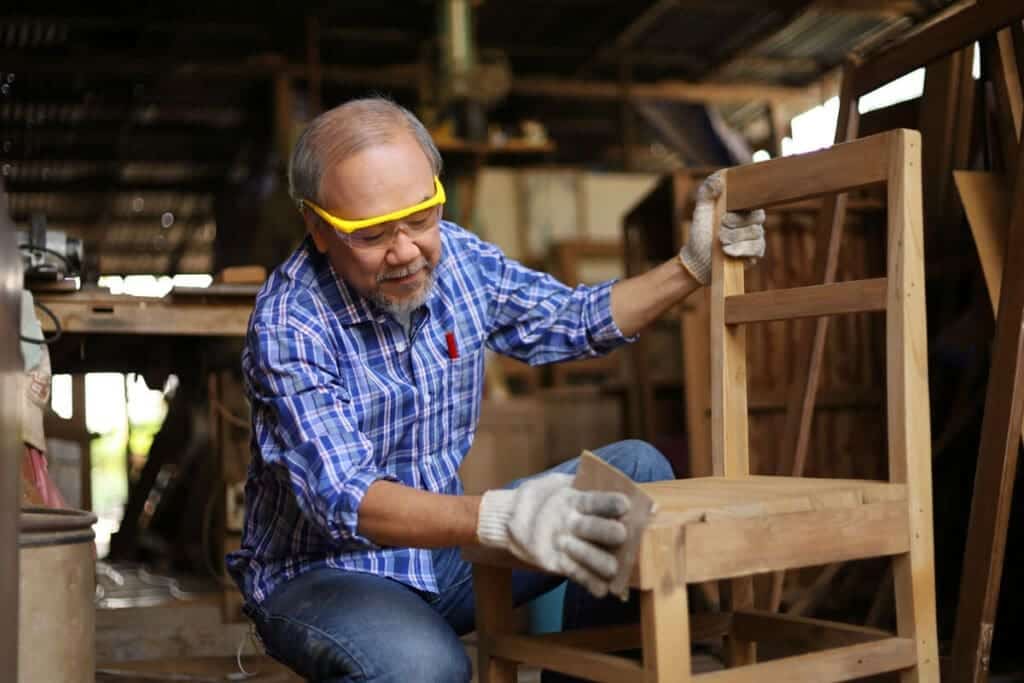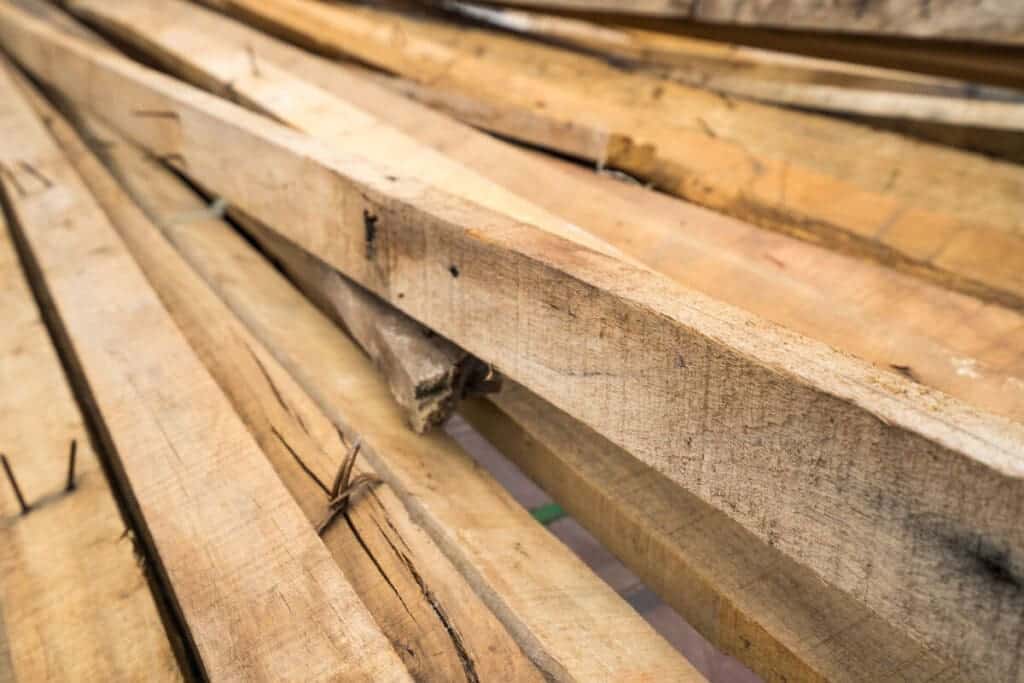As the world continues to be concerned with our climate and environment, finding a way to use waste wood shows that we care about the environment.
Using waste wood can be a great way to use wood while saving the environment. We love using waste wood for recycled wood furniture and love the look and style of this furniture. We also understand that recycled furniture has many advantages and disadvantages that a designer must consider when considering recycled or waste wood for a furniture product.
Table of Contents
- Using Waste Wood – Advantages Of Recycled Wood Furniture Production
- Embracing Sustainability: Top Reasons to Love Recycled Wood
- Using Waste Wood – Disadvantages Of Recycled Wood
- Frequently Asked Questions
- Related Content
Using Waste Wood – Advantages Of Recycled Wood Furniture Production

Typical furniture manufacturing has wood wastage during furniture production. Everything from sawdust to wood scraps is parts of wood wastage used in furniture production.
Recycled Wood furniture helps eliminate a lot of that waste as you use wood that would typically be thrown out or unused. There are many advantages to using recycled timber for furniture production.
Embracing Sustainability: Top Reasons to Love Recycled Wood
In a world increasingly focused on sustainability and environmental responsibility, recycled wood emerges as a shining beacon of eco-friendly practices.
From its unique aesthetic appeal to its role in reducing environmental impact, recycled wood offers a compelling array of benefits beyond mere functionality. Join us as we delve into the world of recycled timber, uncovering the aspects that make it not just a material choice but a statement of our commitment to a more sustainable future. The top reasons we love recycled wood:
Waste Wood Or Recycled Wood Has Multiple Uses
Recycled wood can have multiple uses for items such as hardwood flooring, wall panels, tables, countertops, shelves, cabinets, and anything else that can be used to make timber products.
Reusing Waste Wood Is Environmentally Friendly Wood
Reusing waste wood to become recycled wood is very environmentally friendly. Using reused timber is a great way to save some of the earth’s precious resources.
Recycled Wood Can Have Excellent Quality And Strength
Recycled wood can be stronger than new wood as it often has come from old-growth trees as it is older wood. Recycled wood is wood that can have excellent quality and strength.
Recycled Wood Is A Guilt Free Wood Resource
Recycled wood or waste wood is wood that is being reused or would have mainly been destroyed. Recycled wood is guilt-free as no tree was cut down to make the furniture piece or item.
Recycled Wood Has A Great Distressed Look
As recycled or waste wood is being reused, the wood has a great distressed look; the wood will have knicks, scratches, holes, and other distressed marks already on it. The fact the wood is already distressed gives it a great look.
Recycled Wood Has Consumer Appeal
Recycled wood has a significant consumer appeal. Many consumers want to buy recycled or waste wood products as they are known to be environmentally friendly, and no trees were cut down to make the furniture pieces.
A lot of the wood used for the recycled wood could come from old barns, ships, crates, decommissioned buildings, homes, railroads, pallets, and more. The wood from these places also adds to consumer appeal and interest.
Using Waste Wood – Disadvantages Of Recycled Wood

There are many advantages to using waste wood for furniture and other products, but there can also be some disadvantages to using recycled wood.
Here are some of the top disadvantages of using recycled or waste wood for products:
Waste Wood Must Be Properly Collected
Waste wood must be collected appropriately, so sometimes, the wood can be more expensive. The recycled wood suppliers must know where and how to manage the wood.
Recycled Wood Must Be Properly Sorted
Recycled wood has no standard size, shape, or even width, so the wood must be properly sorted. The wood supplier must be able to sort the wood by its various sizes, types, and quality to be used appropriately.
Recycled Wood Requires Special Wood Processing
Recycled wood requires special wood processing that other woods may not have to do. The wood may need nails, glue, and finish taken off before it can be appropriately used.
Recycled Wood Will Have Distressed Marks
Recycled wood will have distressed marks on it. Many of these marks will be profound, so the end product cannot cover them.
Because of this, recycled wood may not be suitable for the end product you are looking for, and no matter how much you want to use recycled wood, it may not work for you for the look and design that you want.
Recycled Wood May Have Holes
Recycled wood may have holes in it. The additional holes may work for a specific type of furniture and look but may not for some styles.
Recycled Wood May Be More Expensive
Due to the nature and complications of wood processing, recycled wood may be more expensive than other types of wood. The cost will depend on many things, mainly how difficult the wood is to collect or work with to produce the end product.
We love the idea of using recycled wood for all kinds of products, including home furniture items, but we also understand that this type and look of wood may not work for all projects. This is because the wood is unique and comes with a unique look and style.
At Mondoro, we produce furniture items in recycled pine wood. We love the look of the recycled pine wood and all the unique pieces of furniture that can be made using it and other home decor products – we would love to talk to you about how we can help you.
Find out more about how Mondoro can help you create, develop, and manufacture excellent home decor and furniture products – don’t hesitate to contact me, Anita. Check out my email by clicking here or become a part of our community and join our newsletter by clicking here.
Mondoro gives out a FREE Lookbook to anyone interested. You can receive a copy of our latest Lookbook by clicking here.
Listen to our Podcast called Global Trade Gal. You can find it on all major podcast platforms. Try out to listen to one of our podcasts by clicking here.
Subscribe to our Mondoro Company Limited YouTube Channel filled with great videos and information by clicking here.
Frequently Asked Questions
What is waste wood?
Waste wood refers to any type of wood material that is no longer needed or considered useful for its original purpose, such as scrap wood from construction sites, discarded furniture, or wood waste from manufacturing processes.
How is waste wood used in recycled wood furniture?
Waste wood can be repurposed and used in the production of recycled wood furniture. It is often reclaimed, processed, and transformed into new furniture pieces, reducing the need for new wood resources.
What are the environmental benefits of using waste wood for furniture?
Using waste wood for furniture helps reduce deforestation by minimizing the demand for virgin timber. It also prevents wood waste from ending up in landfills, contributing to a more sustainable and circular economy.
What are the advantages of recycled wood furniture?
Recycled wood furniture has several advantages. It offers a unique and rustic aesthetic, adds character to spaces, and can be a conversation starter. Additionally, it reduces the environmental impact associated with new wood production.
Are there any disadvantages to using waste wood in furniture?
Yes, there are a few disadvantages. Waste wood may have irregularities, such as knots, cracks, or other imperfections that can affect the overall quality and structural integrity of the furniture. It may also require additional processing and treatment to ensure durability.
How can a designer ensure the quality of recycled wood furniture?
Designers can carefully inspect and select high-quality waste wood for furniture production. They can also employ skilled craftsmen who have experience working with reclaimed materials to ensure the structural integrity and overall quality of the finished products.
Is recycled wood furniture more expensive than furniture made from new wood?
The cost of recycled wood furniture can vary depending on factors such as the type of wood, craftsmanship, and design complexity. In some cases, it may be more expensive due to the additional effort required to reclaim and process the waste wood.
Can waste wood furniture be as durable as furniture made from new wood?
With proper processing and treatment, waste wood furniture can be just as durable as furniture made from new wood. The key lies in using appropriate techniques, such as reinforcing weak areas or using wood fillers, to enhance strength and stability.
Related Content
Is Teak a Coniferous, Evergreen, or Deciduous Tree? 11 Teak Wood Facts
Teak is a deciduous, not evergreen or coniferous tree. Teak leaves do not fall off in the wintertime, but they fall off in the dry season; in Asia, where teak trees are naturally grown, the dry season is not always the same as winter. As the teak leaves do fall off, the tree is considered to be a deciduous tree.
You can discover more by reading Is Teak a Coniferous, Evergreen, or Deciduous Tree? 11 Teak Wood Facts by clicking here.
10 Steps To Rattan Furniture Manufacturing Process Explained
Real wood furniture costs can vary due to the types of solid wood being used and the grade of the wood. Not all real wood furniture is worth the extra cost, especially if the wood they are using is substandard and the furniture is poorly constructed.
You can read our blog on 10 Steps To Rattan Furniture Manufacturing Process Explained by clicking here.
What Does “FSC Certified” Wood Mean?
FSC means the Forrest Stewardship Council, a nonprofit certification process to ensure that wood used for products is from a managed forest and source. The goal of the FSC is to stop illegal logging activities and certify that wood used for a product has reached the standard to be called FSC-certified wood.
You can learn more by reading our blog, What Does “FSC Certified” Wood Mean? by clicking here.

